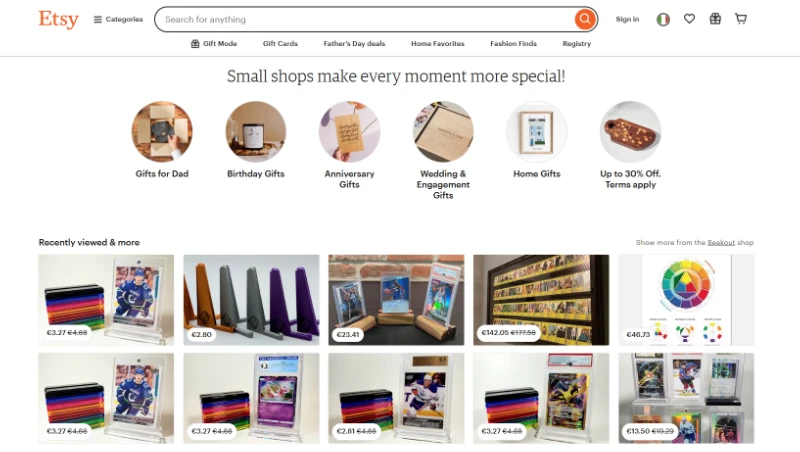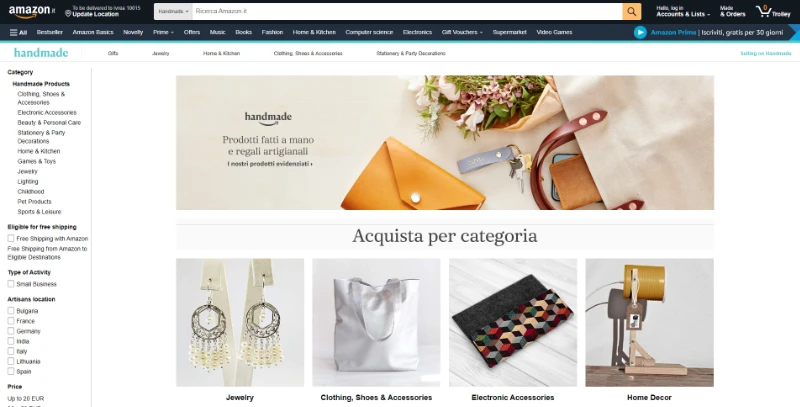Tips and strategies to sell handicrafts online
Published by Incomedia in Guides and Tips · Friday 17 May 2024
"I'm quitting everything and opening a beach bar!" What’s your own “beach bar project”, your plan B, the one that would turn your hobby or passion into your main business and source of income in life?



For many budding artisans, hobbyists and amateur crafters, Plan B is to be able to sell the handmade items they make, so that they can turn the fruits of their creativity and skills into a profitable business. How? Certainly NOT by opening a physical store: it would require too much time and effort for someone who perhaps already has another job. A much better option is taking advantage of online stores, open 24/7, 365 days a year.
You've probably already thought about it yourself, but how do you go about selling your handmade items online?
How do you get started? Is it better to choose specialized marketplaces or develop your own e-commerce?
In this article, we will answer all your questions about this topic.
What to sell: the best-selling craft products
Let’s start from the product: what are the most popular handmade or handcrafted items sold online?
The good news is that handmade products have become more and more fashionable lately, and have experienced great success online.

Among the most popular products sold online, we can find jewelry and accessories, such as necklaces, bracelets, and earrings. Clothing and fashion items are also in vogue: printed T-shirts, bags, wallets, hats, and scarves are always highly sought after.
Another hot area is home goods: wall decorations, pillows, blankets and home furnishings are in high demand. And, in this context, works of art such as paintings, sculptures and photographs are prized by buyers looking for unique pieces to decorate their homes.
These are just a few examples of the most popular products, but there are many more. So, regardless of market trends, feel free to follow your passion and get right at it.
Whatever kind of product you go for, the important thing is that, in some way, it is unique and original. Focus on quality and authenticity: it's the story behind your product, the emotion it evokes that matters most to your potential customers.
In the end, by telling your story in the right way, you can find interested buyers online for a wide variety of items, all over the world.
Selling crafted items online vs offline: pros and cons
When you find yourself looking at your shelves at home now filled with all the items you've created with such care and passion, your initial thought may be to sell them at one of the many markets held in your city, or to rely on local shops as well as on specialized retailers.
Selling in the physical world certainly has its advantages, but what if you compare it with what you can achieve by selling your products directly on the web?
The Internet opens the doors to a much wider audience, offering you new opportunities to turn your passion into a real source of income.
Let's try to compare online and offline sales:
- Audience
Online Sales: You can access a wide global audience thanks to e-commerce platforms and social media.
Offline Sales: You can mainly access local customers or store visitors. - Flexibility
Online Sales: You can manage your shop everywhere offering an internet connection, 24/7.
Offline Sales: More personal interaction with customers, but geographic and hourly limitations. - Costs
Online Sales: Lower initial costs, as you don’t have to rent a physical space.
Offline Sales: Higher operating costs, including rent, utilities and sales space maintenance. - Customer experience
Online Sales: Lack of tactile experience for customers.
Offline Sales: Sensory experience, customers can touch and try products directly. - Interaction with audience
Online Sales: Limited interactions, but possibility of providing online assistance.
Offline Sales: Personal relationships with customers and more direct and personalized customer service.
So, selling online requires a smaller initial investment of time and money, it allows you to reach a much larger audience and sell anywhere, anytime: in short, it represents a more advantageous, faster and easier solution than offline selling. That’s why online selling has been growing steadily for years.
Of course, online sales also have drawbacks you must be aware of: firstly, they don't allow direct interaction with the customer, and secondly, they expose you to a much broader and intense competition.
That’s why you need to know how it is best to proceed to sell your handcrafted products, optimizing your investment without wasting time and efforts, you can spend that on your creations. Let’s find out more about it.
Selling on marketplaces
The easiest and quickest way to start selling your crafted products online is to rely on marketplaces. They are digital platforms that serve as intermediaries between sellers and customers, allowing artisans and crafters to sell their products to a wide audience of potential buyers.
Marketplaces offer many advantages:
- Having a large number of daily visitors from all over the world, they ensure wide visibility.
- They grant user-friendliness by allowing you to quickly upload creations, manage orders and track sales, even without IT skills.
- They offer integrated marketing tools, such as targeted promotions and advertisements, to promote products and to reach an interested audience.
- They enable easy management of the entire purchasing process, including orders, payments and shipping.
- They provide useful customer feedback and review systems to earn buyers' trust through positive comments and recommendations.
- They offer support as well as helpful resources and practical guides on how to optimize sales and improve your offer.
In spite of being an accessible way of selling creations online, marketplaces also have some drawbacks that you need to consider:
- They charge commissions on sales, which, especially on low-cost products, can greatly reduce profit margins.
- Given their popularity, artisans find themselves competing with thousands of other vendors to attract the attention of buyers. This intense competition can make it difficult to stand out in the crowd.
- They generally offer limited opportunities for storefront customization. This can make it difficult to succeed in conveying the uniqueness and value of one's brand and creations.
- They have rules and restrictions that limit autonomy and control over sales policies and buyer experiences.
All of this is compounded by the fact that relying solely on marketplaces for sales can make you vulnerable to changes in platform policies or algorithms. Think about it: what would happen if you were selling on just one marketplace and for some reason your products started to be penalized, or your account got suspended? And what if unilateral changes were introduced to the commissions? It's easy to understand that all of this would have a significant impact on your income and on your business.
You should therefore consider trying different platforms. Usually, opening an account and start selling is free, so you can spend some time trying different marketplaces until you find the one that best suits your needs.
That being said, however, you shouldn't stop there but explore other options as well, such as creating your own independent online store. This way, you could benefit from both sides: leverage the audience and reputation of marketplaces to make yourself known and use your own proprietary online store to be independent and maximize earnings.
The best online platforms to sell crafted products
Now, you are probably wondering: “Which are the most popular marketplaces I could sell my creations on?”
There are in fact many possibilities. You definitely need to check these out:
Etsy
At the moment, it's certainly the most widely used marketplace for selling handmade creations internationally. It is an online marketplace where artisans can open their own shop. The most popular products include jewelry, home decor, gift ideas, as well as DIY craft kits. Etsy allows you to reach a very broad audience, especially in countries like the USA, UK, Germany, and Spain; however, competition on this platform is very high.

Opening your own shop on Etsy is pretty easy and, above all, it can be managed both from PC and smartphone using the dedicated app. Subscribing is free of charge, but there are some later costs you must consider: a listing fee (€0.19); a transaction fee (6.5% of the sale price); and a payment processing fee if you accept Etsy Payments (4% + €0.30 when the item is sold).
We mentioned Etsy also on this guide: Selling on Etsy is Good (but not Enough)
Amazon Handmade
Handmade is the online platform provided by Amazon: it has its own category, and it’s dedicated to handcrafted products only. This platform is active for many countries, and it allows you to reach a very large audience. Also in this case, opening a shop is very easy and, moreover, you can rely on the efficient backend and logistic system that made Amazon so popular worldwide.

Creating your own store on Amazon Handmade is free, but there is a 15% commission on each sale you make.
Other marketplaces
On top of these two real giants in the industry, there are more marketplaces that are worth testing.
Among those conceived specifically for who creates handcrafted products, and which happen to be Italian too, we have:
- Mooza
- Mirta
- Artemest
- Ad Hoc Atelier
All the marketplaces we mentioned until now allow selling to the end user directly. There are, however, other platforms that, on the other hand, allow selling handicraft products in bulk, becoming a point of contact between artisans and shops all over the world. Among these online wholesale marketplaces, we can mention:
- Faire
- Orderchamp
- Fairling
Creating your own online shop
Is selling on marketplaces convenient? Yes, it is.
Is it enough? No, it isn’t.
As you may have understood, marketplaces are fantastic for reaching a very wide audience, but they don't allow you to be fully autonomous and, above all, they imply commissions. To take your online artisan business to the next level, the best thing you can do is to complement your presence on marketplaces with the creation of your own website, complete with e-commerce functionality.
With your own online shop, you can:
- introduce yourself, your passion and your business in the best possible way, stressing the uniqueness of your offering;
- tell your story, possibly using a blog, and therefore get in touch with your audience.
- establish a more direct contact with your customers, and manage your contact database all by yourself;
- be free from any logics and conditions unilaterally imposed by third party platforms;
- collect 100% of the sales price without having to give commissions away.
Building a professional website with an integrated online shop is now within reach for everyone. With software like WebSite X5, you can create it yourself, even if you're not an expert, have limited time to dedicate to your website, and don't want to invest a significant amount of money in it.
The best solution is to start off a good template, such as Crafty Gift, Handmade or The Vintage Shop: they provide all the necessary pages as well as a preset online shop and are optimized for browsing on mobile. Of course, you are free to fully customize them. Add your contents and your products, and you will be ready to go online in no time.
WebSite X5 is an all-in-one solution: the software license includes an automatic domain and a Webspace free for 12 months.
Conclusions
If you’re an artisan or a crafter, you’re surely not afraid of learning new things, experimenting, and putting your creativity and skills into action: actually, that’s what you probably enjoy doing.
These are all qualities that will prove invaluable in promoting and selling your creations online, ensuring that your hobby also becomes a source of income for you.

